Elena Cabrio
WIMMICS
Beating Harmful Stereotypes Through Facts: RAG-based Counter-speech Generation
Oct 14, 2025Abstract:Counter-speech generation is at the core of many expert activities, such as fact-checking and hate speech, to counter harmful content. Yet, existing work treats counter-speech generation as pure text generation task, mainly based on Large Language Models or NGO experts. These approaches show severe drawbacks due to the limited reliability and coherence in the generated countering text, and in scalability, respectively. To close this gap, we introduce a novel framework to model counter-speech generation as knowledge-wise text generation process. Our framework integrates advanced Retrieval-Augmented Generation (RAG) pipelines to ensure the generation of trustworthy counter-speech for 8 main target groups identified in the hate speech literature, including women, people of colour, persons with disabilities, migrants, Muslims, Jews, LGBT persons, and other. We built a knowledge base over the United Nations Digital Library, EUR-Lex and the EU Agency for Fundamental Rights, comprising a total of 32,792 texts. We use the MultiTarget-CONAN dataset to empirically assess the quality of the generated counter-speech, both through standard metrics (i.e., JudgeLM) and a human evaluation. Results show that our framework outperforms standard LLM baselines and competitive approach, on both assessments. The resulting framework and the knowledge base pave the way for studying trustworthy and sound counter-speech generation, in hate speech and beyond.
Effectiveness of Counter-Speech against Abusive Content: A Multidimensional Annotation and Classification Study
Jun 13, 2025Abstract:Counter-speech (CS) is a key strategy for mitigating online Hate Speech (HS), yet defining the criteria to assess its effectiveness remains an open challenge. We propose a novel computational framework for CS effectiveness classification, grounded in social science concepts. Our framework defines six core dimensions - Clarity, Evidence, Emotional Appeal, Rebuttal, Audience Adaptation, and Fairness - which we use to annotate 4,214 CS instances from two benchmark datasets, resulting in a novel linguistic resource released to the community. In addition, we propose two classification strategies, multi-task and dependency-based, achieving strong results (0.94 and 0.96 average F1 respectively on both expert- and user-written CS), outperforming standard baselines, and revealing strong interdependence among dimensions.
CasiMedicos-Arg: A Medical Question Answering Dataset Annotated with Explanatory Argumentative Structures
Oct 07, 2024Abstract:Explaining Artificial Intelligence (AI) decisions is a major challenge nowadays in AI, in particular when applied to sensitive scenarios like medicine and law. However, the need to explain the rationale behind decisions is a main issue also for human-based deliberation as it is important to justify \textit{why} a certain decision has been taken. Resident medical doctors for instance are required not only to provide a (possibly correct) diagnosis, but also to explain how they reached a certain conclusion. Developing new tools to aid residents to train their explanation skills is therefore a central objective of AI in education. In this paper, we follow this direction, and we present, to the best of our knowledge, the first multilingual dataset for Medical Question Answering where correct and incorrect diagnoses for a clinical case are enriched with a natural language explanation written by doctors. These explanations have been manually annotated with argument components (i.e., premise, claim) and argument relations (i.e., attack, support), resulting in the Multilingual CasiMedicos-Arg dataset which consists of 558 clinical cases in four languages (English, Spanish, French, Italian) with explanations, where we annotated 5021 claims, 2313 premises, 2431 support relations, and 1106 attack relations. We conclude by showing how competitive baselines perform over this challenging dataset for the argument mining task.
* 9 pages
Is Safer Better? The Impact of Guardrails on the Argumentative Strength of LLMs in Hate Speech Countering
Oct 04, 2024Abstract:The potential effectiveness of counterspeech as a hate speech mitigation strategy is attracting increasing interest in the NLG research community, particularly towards the task of automatically producing it. However, automatically generated responses often lack the argumentative richness which characterises expert-produced counterspeech. In this work, we focus on two aspects of counterspeech generation to produce more cogent responses. First, by investigating the tension between helpfulness and harmlessness of LLMs, we test whether the presence of safety guardrails hinders the quality of the generations. Secondly, we assess whether attacking a specific component of the hate speech results in a more effective argumentative strategy to fight online hate. By conducting an extensive human and automatic evaluation, we show how the presence of safety guardrails can be detrimental also to a task that inherently aims at fostering positive social interactions. Moreover, our results show that attacking a specific component of the hate speech, and in particular its implicit negative stereotype and its hateful parts, leads to higher-quality generations.
Medical mT5: An Open-Source Multilingual Text-to-Text LLM for The Medical Domain
Apr 11, 2024Abstract:Research on language technology for the development of medical applications is currently a hot topic in Natural Language Understanding and Generation. Thus, a number of large language models (LLMs) have recently been adapted to the medical domain, so that they can be used as a tool for mediating in human-AI interaction. While these LLMs display competitive performance on automated medical texts benchmarks, they have been pre-trained and evaluated with a focus on a single language (English mostly). This is particularly true of text-to-text models, which typically require large amounts of domain-specific pre-training data, often not easily accessible for many languages. In this paper, we address these shortcomings by compiling, to the best of our knowledge, the largest multilingual corpus for the medical domain in four languages, namely English, French, Italian and Spanish. This new corpus has been used to train Medical mT5, the first open-source text-to-text multilingual model for the medical domain. Additionally, we present two new evaluation benchmarks for all four languages with the aim of facilitating multilingual research in this domain. A comprehensive evaluation shows that Medical mT5 outperforms both encoders and similarly sized text-to-text models for the Spanish, French, and Italian benchmarks, while being competitive with current state-of-the-art LLMs in English.
Argument Quality Assessment in the Age of Instruction-Following Large Language Models
Mar 24, 2024
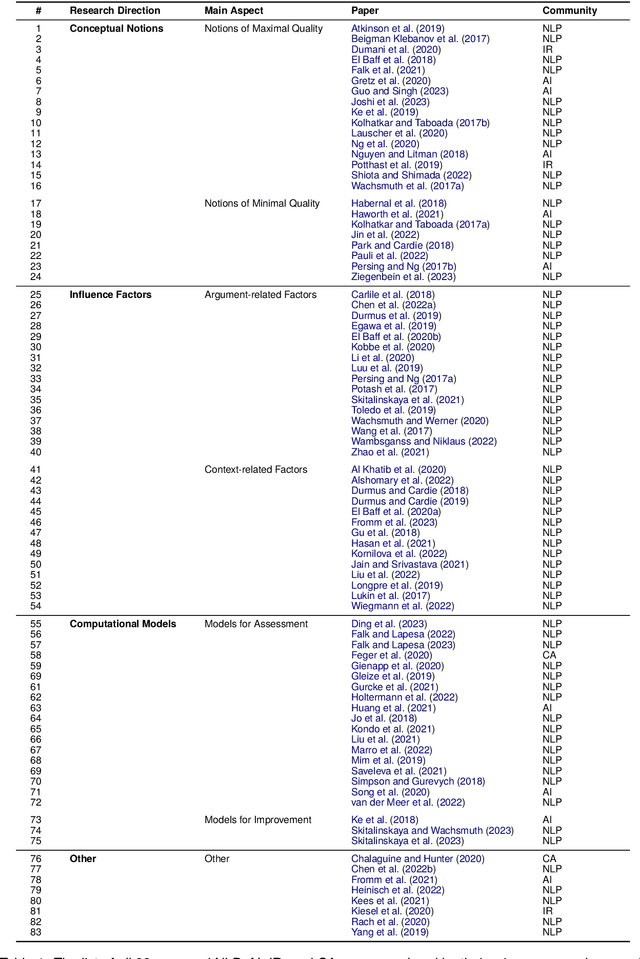

Abstract:The computational treatment of arguments on controversial issues has been subject to extensive NLP research, due to its envisioned impact on opinion formation, decision making, writing education, and the like. A critical task in any such application is the assessment of an argument's quality - but it is also particularly challenging. In this position paper, we start from a brief survey of argument quality research, where we identify the diversity of quality notions and the subjectiveness of their perception as the main hurdles towards substantial progress on argument quality assessment. We argue that the capabilities of instruction-following large language models (LLMs) to leverage knowledge across contexts enable a much more reliable assessment. Rather than just fine-tuning LLMs towards leaderboard chasing on assessment tasks, they need to be instructed systematically with argumentation theories and scenarios as well as with ways to solve argument-related problems. We discuss the real-world opportunities and ethical issues emerging thereby.
A Dataset Independent Set of Baselines for Relation Prediction in Argument Mining
Feb 14, 2020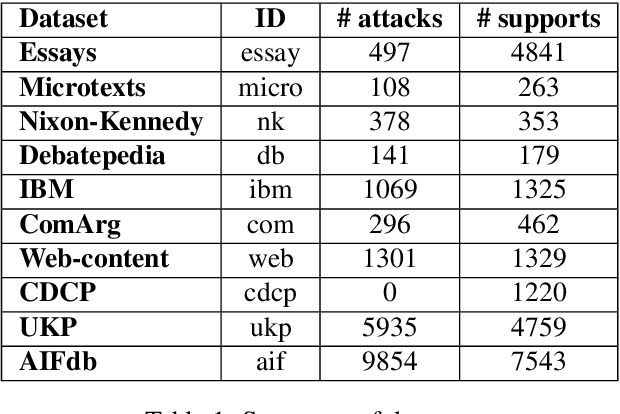
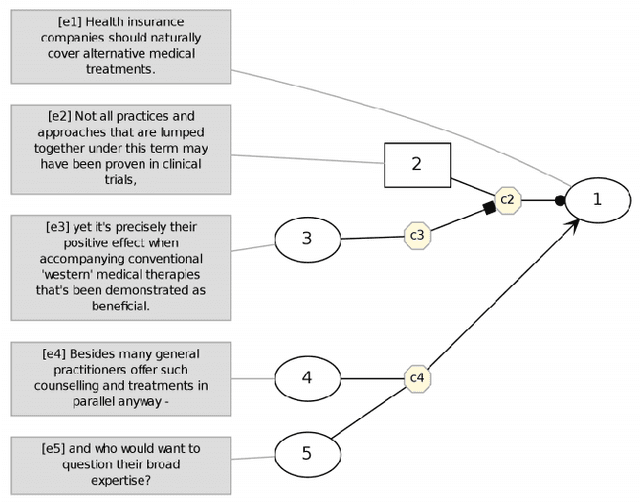
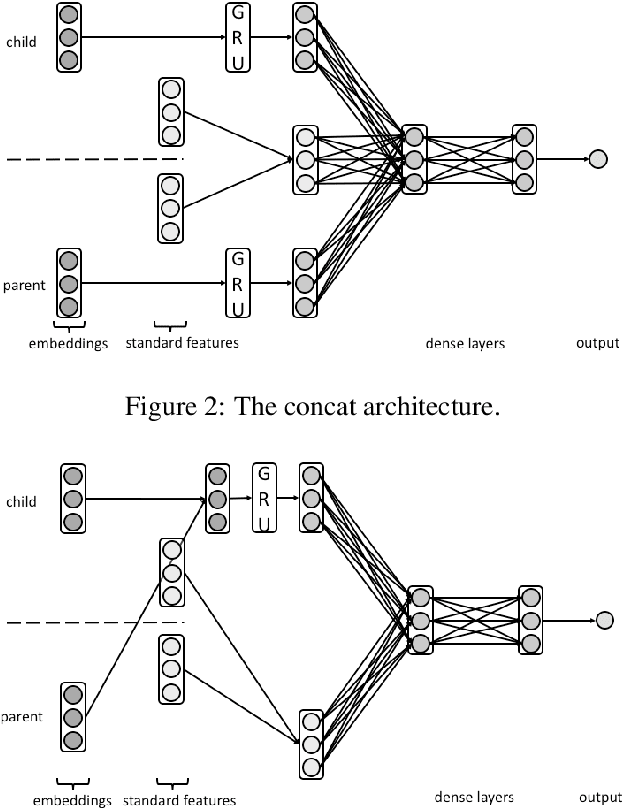
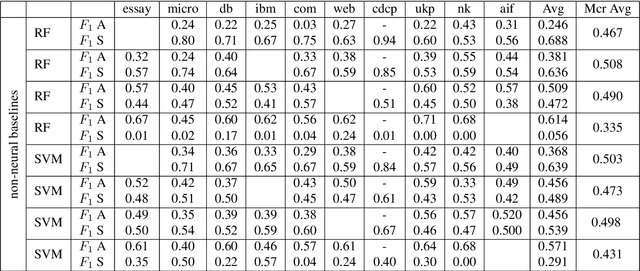
Abstract:Argument Mining is the research area which aims at extracting argument components and predicting argumentative relations (i.e.,support and attack) from text. In particular, numerous approaches have been proposed in the literature to predict the relations holding between the arguments, and application-specific annotated resources were built for this purpose. Despite the fact that these resources have been created to experiment on the same task, the definition of a single relation prediction method to be successfully applied to a significant portion of these datasets is an open research problem in Argument Mining. This means that none of the methods proposed in the literature can be easily ported from one resource to another. In this paper, we address this problem by proposing a set of dataset independent strong neural baselines which obtain homogeneous results on all the datasets proposed in the literature for the argumentative relation prediction task. Thus, our baselines can be employed by the Argument Mining community to compare more effectively how well a method performs on the argumentative relation prediction task.
Love Me, Love Me, Say that You Love Me: Enriching the WASABI Song Corpus with Lyrics Annotations
Dec 05, 2019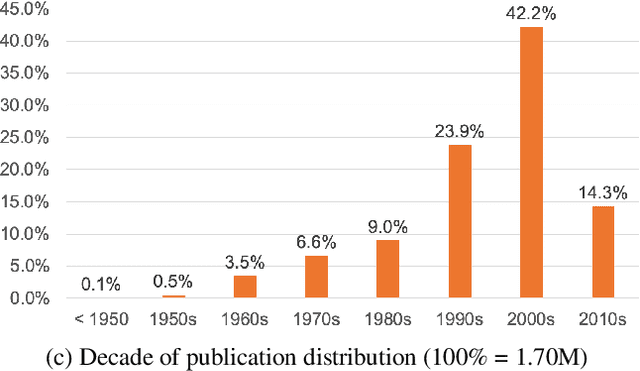
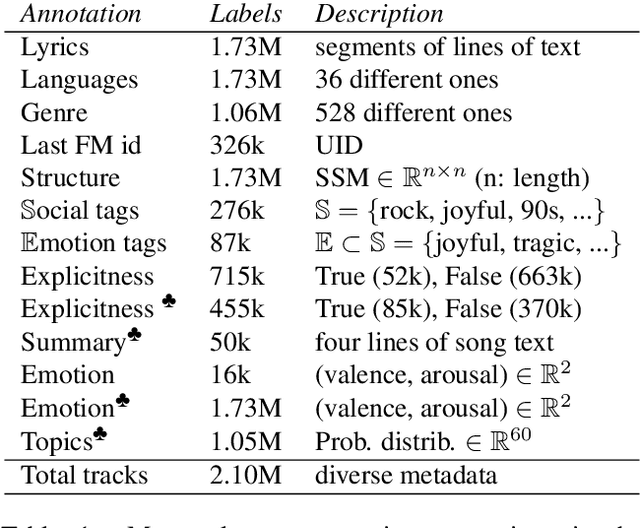
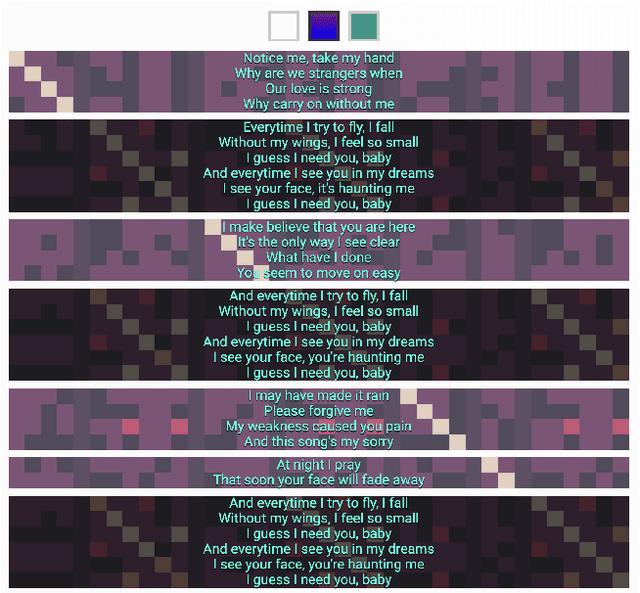
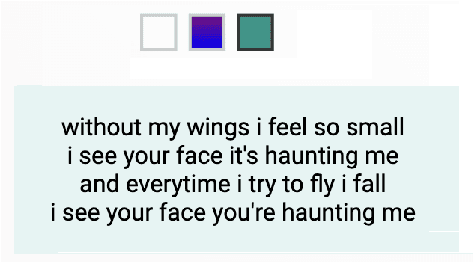
Abstract:We present the WASABI Song Corpus, a large corpus of songs enriched with metadata extracted from music databases on the Web, and resulting from the processing of song lyrics and from audio analysis. More specifically, given that lyrics encode an important part of the semantics of a song, we focus here on the description of the methods we proposed to extract relevant information from the lyrics, such as their structure segmentation, their topics, the explicitness of the lyrics content, the salient passages of a song and the emotions conveyed. The creation of the resource is still ongoing: so far, the corpus contains 1.73M songs with lyrics (1.41M unique lyrics) annotated at different levels with the output of the above mentioned methods. Such corpus labels and the provided methods can be exploited by music search engines and music professionals (e.g. journalists, radio presenters) to better handle large collections of lyrics, allowing an intelligent browsing, categorization and segmentation recommendation of songs.
Graph Data on the Web: extend the pivot, don't reinvent the wheel
Mar 11, 2019Abstract:This article is a collective position paper from the Wimmics research team, expressing our vision of how Web graph data technologies should evolve in the future in order to ensure a high-level of interoperability between the many types of applications that produce and consume graph data. Wimmics stands for Web-Instrumented Man-Machine Interactions, Communities, and Semantics. We are a joint research team between INRIA Sophia Antipolis-M{\'e}diterran{\'e}e and I3S (CNRS and Universit{\'e} C{\^o}te d'Azur). Our challenge is to bridge formal semantics and social semantics on the web. Our research areas are graph-oriented knowledge representation, reasoning and operationalization to model and support actors, actions and interactions in web-based epistemic communities. The application of our research is supporting and fostering interactions in online communities and management of their resources. In this position paper, we emphasize the need to extend the semantic Web standard stack to address and fulfill new graph data needs, as well as the importance of remaining compatible with existing recommendations, in particular the RDF stack, to avoid the painful duplication of models, languages, frameworks, etc. The following sections group motivations for different directions of work and collect reasons for the creation of a working group on RDF 2.0 and other recommendations of the RDF family.
SMILK, linking natural language and data from the web
Dec 20, 2018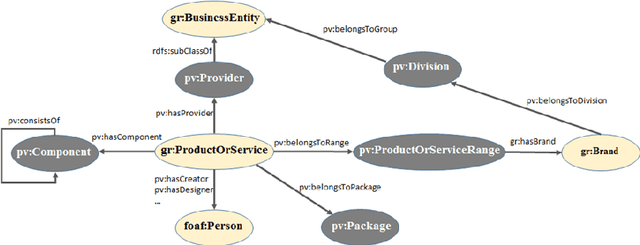
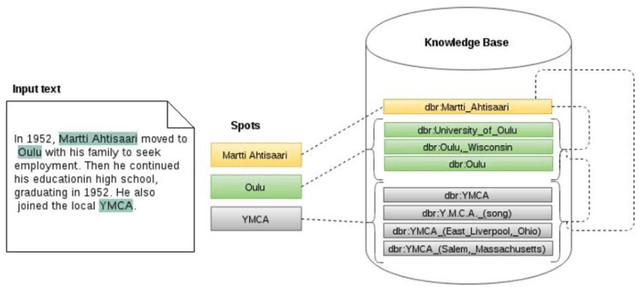
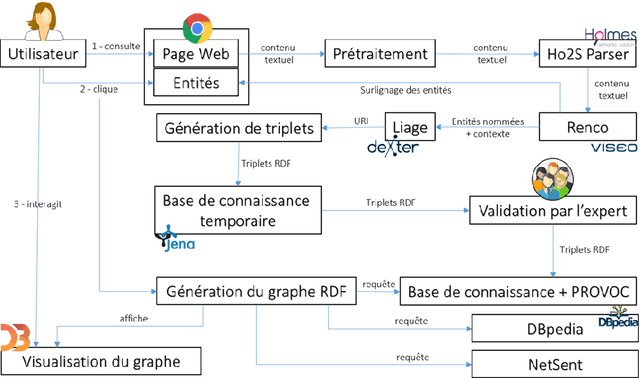
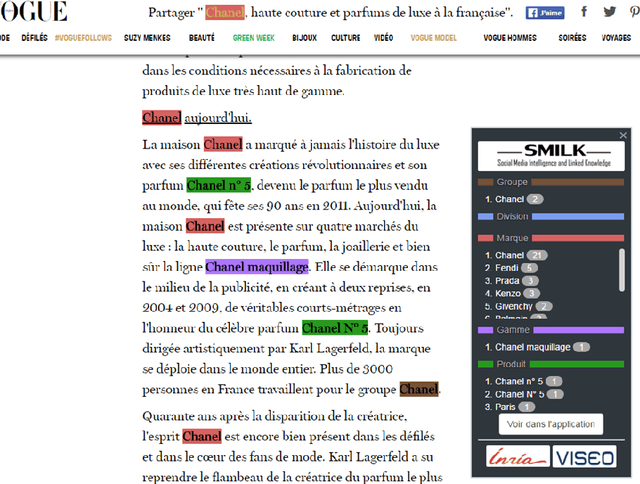
Abstract:As part of the SMILK Joint Lab, we studied the use of Natural Language Processing to: (1) enrich knowledge bases and link data on the web, and conversely (2) use this linked data to contribute to the improvement of text analysis and the annotation of textual content, and to support knowledge extraction. The evaluation focused on brand-related information retrieval in the field of cosmetics. This article describes each step of our approach: the creation of ProVoc, an ontology to describe products and brands; the automatic population of a knowledge base mainly based on ProVoc from heterogeneous textual resources; and the evaluation of an application which that takes the form of a browser plugin providing additional knowledge to users browsing the web.
* in French
 Add to Chrome
Add to Chrome Add to Firefox
Add to Firefox Add to Edge
Add to Edge